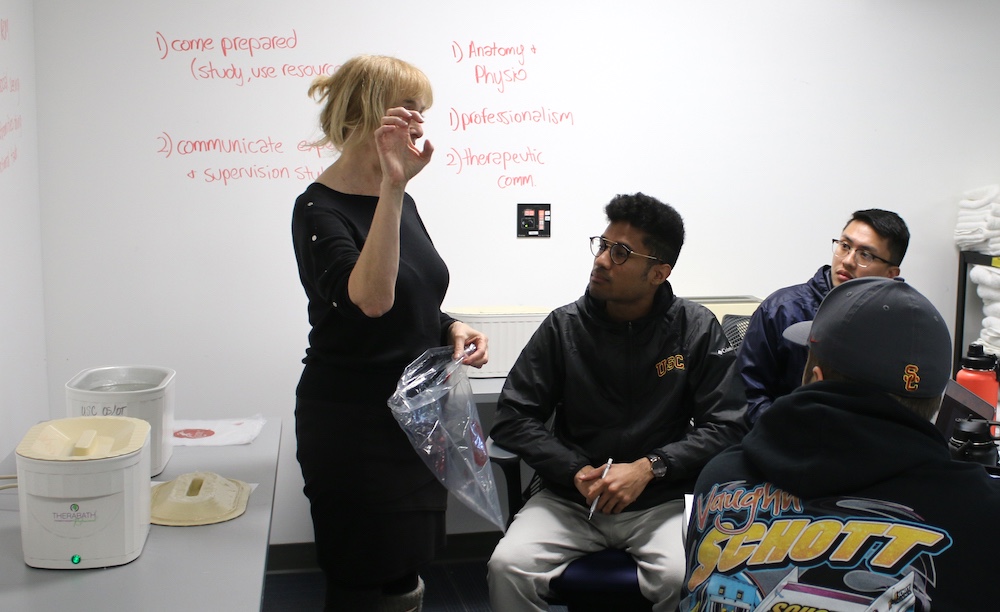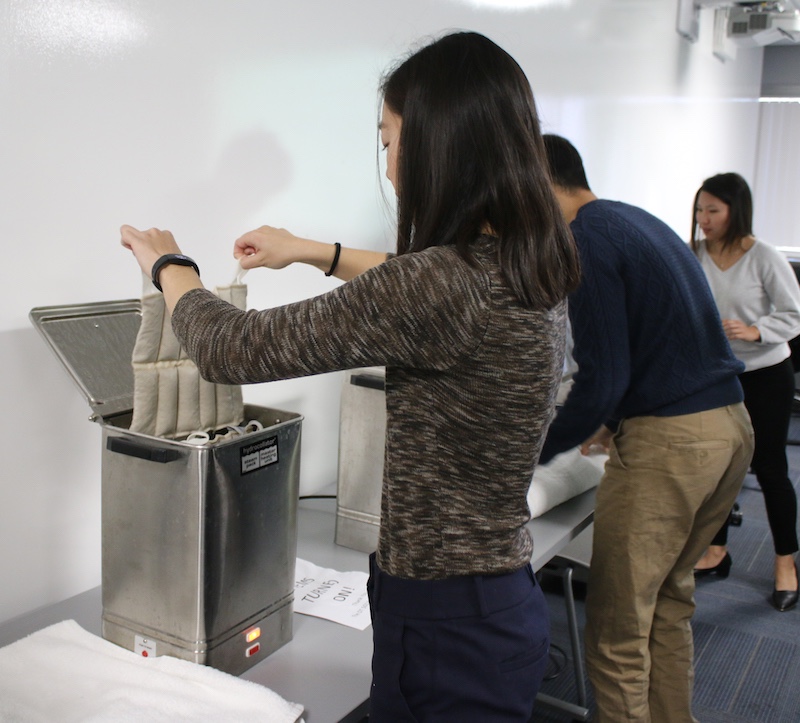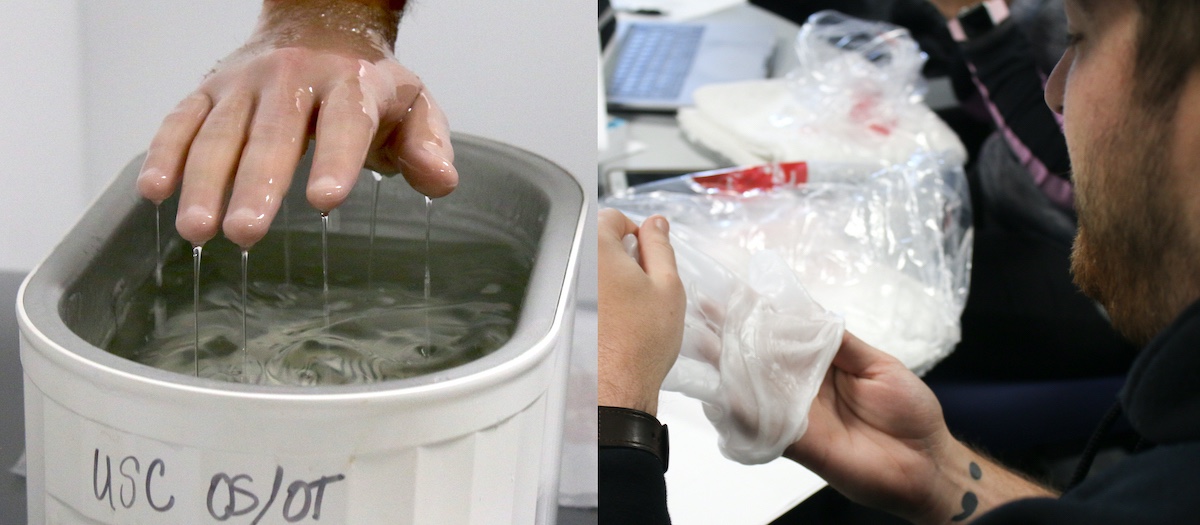Lifestyle Redesign
News
A “hands-on” approach to teaching
February 13, 2020
Janice Rocker, who spends most of her time working in the hand therapy clinic at Keck Hospital of USC, brings her clinical experience to the classroom for OT 562 “Advance Practice in Hand Therapy and Physical Agent Modalities.”
By Kevin Uhrik / HSC News
As a student in the entry-level master’s program at USC, I am grateful for the opportunity to be taught and mentored by the clinical faculty members of the Chan Division. The clinical faculty members at USC have a longstanding history of both teaching and clinical excellence, and are constantly striving to provide the best possible services they can. In addition to the USC Occupational Therapy Faculty Practice, which mainly focuses on Lifestyle Redesign® services, you can find clinical faculty members providing occupational therapy on the USC Health Science Campus at Keck Hospital of USC and USC Norris Cancer Hospital.
Throughout the master’s program, clinical faculty members teach courses in their specific areas of expertise, and provide guest lectures to enhance the mental health, pediatric and adult physical rehabilitation immersion experiences. For instance, during the adult physical rehabilitation immersion, Assistant Clinical Professor Janice Rocker provided an introductory lecture on hand therapy and physical agent modalities. During this lecture, Dr. Rocker showcased many different aspects of hand therapy, which inspired several students, including me, to pursue additional education in hand therapy and physical agent modalities.
Left: Master’s student Joseph Schott gets “first-hand” experience in OT 562 “Advance Practice in Hand Therapy and Physical Agent Modalities.” Right: Schott demonstrates a flawless paraffin wax glove removal.
Considering my new passion to pursue hand therapy, it was an easy choice to take the elective course OT 562 “Advance Practice in Hand Therapy and Physical Agent Modalities,” which is taught by Dr. Rocker. During this elective, I have had the privilege to learn through educational materials, practicum experiences and by hearing about Dr. Rocker’s own personal clinical experiences as the coordinator of the outpatient hand and upper extremity rehabilitation program at Keck Medical Center of USC.
I recently sat down with Dr. Rocker to learn more about her perspectives on education and practice. Below is a Q&A of our conversation, which is condensed and edited for clarity.
How do you feel your clinical experience helps you within the classroom setting?
I think it’s important to bring my clinical cases to the classroom because they bring the material to life. Rather than just having a lecture, you instead have a real person to connect with, including all the dynamics that go with that person. Along with the physical client presentation, a real person provides a glimpse into the psychosocial aspects of occupational therapy that bring the whole clinical picture to life.
I think that photos and videos of clients are very helpful for students, specifically as students are trying to figure out what to make out of all the readings. It’s a lot more interesting to listen to a case after you have already read all of the information about why you might use a specific modality, but can then see that modality used on a real person and how it affected that person.
Conversely, how do your teaching experiences help inform your clinical practice?
When I’m teaching, I have to stay really current. I mean, I try to stay current anyways, but students are fresh, which makes everything fresh. So a student might ask me a question where I go, ‘hmm . . . let me think about that.’ Or I might be back in the clinic, and thinking about whatever the student brought up to continually improve my clinical reasoning. So students are teaching me all the time — I get to teach and learn at the same time!
Additionally, we bring students into our clinic at Keck often because our clients and physicians are always happy to have them for the fresh perspectives they bring to our practice. It’s a good learning environment for everybody. It’s not a one-way street — I’m learning from students all the time. Everybody learns differently, and everybody processes information differently, so that is why it is always fascinating to learn from others.
You are a Certified Structural Yoga Therapist; can you tell me more about this certification and how you incorporate it into your teaching and clinical practice?
The majority of our clients are seeing us because of pain. There are so many different ways to approach pain, and I wanted to have another option. So I did the Structural Yoga Therapy certification because structural yoga has an approach where we are looking at muscles and postures while performing yoga, and I’m a big yoga person in my own life!
While I do so many things using yoga, I do not call these techniques ‘yoga’ because people sometimes think they have to put their foot behind their neck! So instead, I lead them through poses to enhance their breathing or to move more naturally. Some people, if they like yoga, or if it is an occupation they want to get back to, love when I incorporate a couple yoga techniques into whatever therapy exercise they are doing.
For example, say you broke your wrist and you cannot put a lot of weight in your palm to do the downward dog yoga position. In this case, I would have you come onto your forearms or do the pose against a tabletop or a bed. There are a lot of ways to modify yoga positions based on the client’s needs and goals. I feel like yoga has really helped me as a person. And if I ever have a difficult client, I can use yoga or breathing techniques myself before our appointment in order to help me help them!
Hand therapy does not just stop at the wrist. For instance, if a person is doing the warrior pose, they have to balance through their core and their legs. So if someone is feeling depressed and has kyphotic posture, some of these poses can bring them a sense of balance or control. A lot of times, psychologically and physically, balance becomes disrupted after an injury. Structural yoga combined with hand therapy can bring a sense of control back into the lives of our clients.
⋯










